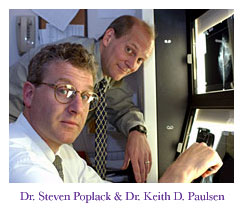
|
For Release: May 3, 2004
Contact: DMS Communications(603) 650-1492
Print Version
Alternative/Supplemental Breast Imaging Methods Tested
HANOVER, NH-Dartmouth physicians and engineers are collaborating to test three new imaging techniques to find breast abnormalities, including cancer. Results from the first stage of their research, information about the electro-magnetic characteristics of healthy breast tissue, appears in the May issue of Radiology, the journal of the Radiological Society of North America.

The interdisciplinary Dartmouth team, which includes researchers from Dartmouth Medical School and the Thayer School of Engineering working with experts at the Norris Cotton Cancer Center and radiologists at Dartmouth-Hitchcock Medical Center, is developing and testing imaging techniques to learn about breast tissue structure and behavior. The techniques are electrical impedance spectral imaging (EIS), microwave imaging spectroscopy (MIS), and near infrared (NIR) spectral imaging.

"This study offers the foundation for future research and clinical trials," said Dr. Steven Poplack, associate professor of radiology and obstetrics/gynecology at Dartmouth Medical School, and the lead author of the paper. "We're establishing normal ranges for healthy breast tissue characteristics in order to more easily recognize the abnormalities."
The study of 23 healthy women offers baseline data from the three techniques. The methods are not invasive or particularly uncomfortable for participants, and they all provide detailed information about different properties of breast tissue.
- EIS: This painless test uses a very low voltage electrode system to examine how the breast tissue conducts and stores electricity. Living cell membranes carry an electric potential that affects the way a current flows, and different cancer cells have different electrical characteristics.
- MIS: This exam involves the propagation of very low levels (1000 times less than a cell phone) of microwave energy through breast tissue to measure electrical properties. This technique is particularly sensitive to water. Generally, tumors have been found to have more water and blood than regular tissue.
- NIR: Infrared light is sensitive to blood, so by sending infrared light through breast tissue with a fiber optic array, the researchers are able to locate and quantify regions of oxygenated and deoxygenated hemoglobin. This might help detect early tumor growth and characterize the stage of a tumor by learning about its vascular makeup.
Dr. Keith D. Paulsen, professor of engineering and a co-author of the study, is the principal investigator of this research program, which is funded by the National Cancer Institute. Other authors on the paper include Dr. Alexander Hartov, Dr. Paul M. Meaney, Dr. Brian W. Pogue, Dr. Tor D. Tosteson, Margaret R. Grove, Sandra K. Soho and Wendy A. Wells, all associated with Dartmouth's Thayer School of Engineering or Dartmouth Medical School.
-DMS-